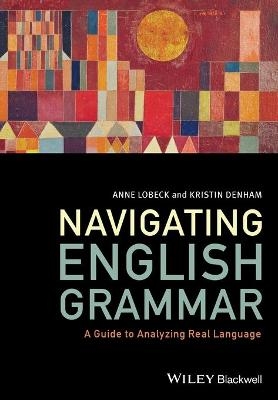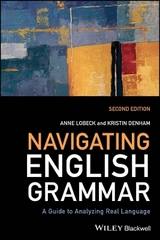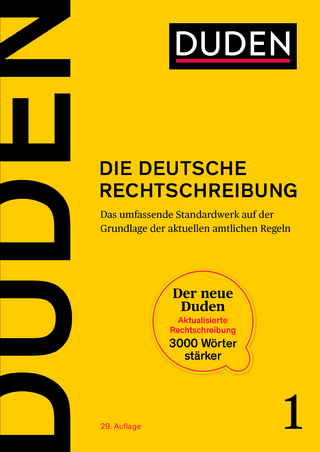
Navigating English Grammar
Wiley-Blackwell (Verlag)
978-1-4051-5994-4 (ISBN)
- Titel erscheint in neuer Auflage
- Artikel merken
Presents a novel, inquiry-based approach to understanding speakers' unconscious knowledge of English grammar
Makes lucid connections, when relevant, with current linguistic theory
Integrates language change and variation into the study of grammar
Examines historical sources of socially evaluative perceptions of grammar, as 'good' or 'bad', and notions of language authority
Provides syntactic explanations for many modern punctuation rules
Explores some of the current controversies about grammar teaching in school and the role of Standard English in testing and assessment
Anne Lobeck is Professor of English and Linguistics at Western Washington University. She is author of Ellipsis: Functional Heads, Licensing and Identification (1995) and Discovering Grammar: An Introduction to English Sentence Structure (2000), and is coeditor and co-author (with Kristin Denham) of several books, including Linguistics at School: Language Awareness in Primary and Secondary Education (2010). Kristin Denham is Professor of English and Linguistics at Western Washington University. She is coeditor (with Anne Lobeck) of two volumes, including Language in the Schools: Integrating Linguistic Knowledge into K-12 Teaching (2005) and co-author (with Anne Lobeck) of Linguistics for Everyone: An Introduction (2010).
Preface xiii
Acknowledgments xv
1 What is Grammar and How Do We Study It? 1
Introduction 1
What is English? Language Change and Variation 2
What is Grammar? Prescriptive and Descriptive Grammar 4
Origins of Prescriptive Grammar 8
The Components of Grammar 10
Syntax 10
Morphology 13
Semantics 15
Phonetics and phonology 18
The Scientific Study of Language 19
Exercises 20
2 Nouns 23
Introduction 23
Semantic Features of Nouns 24
Abstract and concrete 25
Common and proper 25
Count and mass 27
Collective nouns 28
Generic nouns 29
Noun Morphology 30
Inflectional affixation 30
Plurals 30
Possessives 31
Derivational affixation 33
Other ways we form nouns 34
Summary 35
Exercises 35
3 Noun Phrases 41
Introduction 41
Categories that Precede Nouns 42
Determiners 42
Noun phrases without determiners 46
Numerals 47
Quantifiers 48
Order of D, NUM, and Q 49
Partitive, Measure, and Collective Noun Phrases 50
Possessive Noun Phrases 52
NP or N: pronoun substitution 53
Modifiers of Nouns 55
Adjectives that modify nouns 55
Nouns that modify nouns 57
Verbs that modify nouns 59
Summary 61
Exercises 61
4 Verbs 67
Introduction 67
Main Verbs 68
Main Verb Morphology 68
Derivational affixation and other ways we form verbs 69
Inflectional affixation 69
Infinitives 71
Present tense 72
Past tense 74
Past tense variation 75
Present and past participles 76
Past participle variation 77
Suppletion 79
Summary 80
Exercises 81
5 Verb Phrases 85
Introduction 85
Auxiliary Verbs 86
Morphology of have and be 87
Auxiliary have 87
Main verb have 87
Auxiliary be 88
Main verb be 88
Verb strings with auxiliary have and be 89
Modals 90
Modal meaning 90
Modal morphology and tense 92
Semi-modals 93
Future tense 94
Verb strings with auxiliaries and modals 94
Aspect 96
Progressive aspect 96
Perfect aspect 97
Combining aspectual forms 97
Habitual aspect 99
Voice 100
Direct objects and transitivity 101
Thematic roles 102
Passive voice 103
The passive verb string 105
Passive in writing 106
Summary 108
Exercises 108
6 The Clause 113
Introduction 113
Clause Structure and the TENSE Position 114
Subject–Auxiliary Inversion 117
Auxiliary Do 121
Do-insertion 123
Subjects 125
Non-agentive subjects 126
Subjects of passive sentences 127
Pleonastic subjects 127
Tag Question Formation 129
Negation 132
A Final Puzzle: Main Verb Be 137
Summary 141
Exercises 142
7 Adjectives 147
Introduction 147
Adjective Semantics 148
Adjective Morphology 151
Derivational affixation and other ways we form adjectives 151
Participial adjectives 152
Inflectional affixation: comparative and superlative adjectives 152
Adjective Syntax 154
Modifiers of adjectives 154
The degree word test for adjectives 155
Prenominal and postnominal adjective phrases 157
Some interesting exceptions 158
Adjective phrase subjective complements 159
Other subjective complements: NP and PP 160
Direct objects versus subjective complements 161
The seem test for adjectives 162
Restrictions on AP complements 163
Summary 164
Exercises 164
8 Adverbs 171
Introduction 171
Adverb Semantics 172
Adverb Morphology 173
Derivational affixation and other ways we form adverbs 173
Flat adverbs 174
Inflectional affixation 175
Adverb Syntax 176
Modifiers of adverbs 176
Adverb phrase positions 178
Adverb phrase modifiers 180
Adverb phrase complements 181
More on Modifiers 182
Summary 182
Exercises 182
9 Prepositions and Particles 187
Introduction 187
Preposition Semantics 188
Preposition Morphology 190
Preposition Syntax 191
Complements of prepositions 191
Objects of prepositions 191
Other complements of prepositions 192
Modifiers of prepositions 192
Grammatical functions of prepositional phrases 193
PP modifiers of nouns 194
PP modifiers of verbs and clauses 194
PPs as complements 195
Indirect object complements 197
Particles 200
Semantics of particles 200
Syntax of particles 201
Summary 204
Exercises 204
10 Independent, Coordinate, and Subordinate Clauses 209
Introduction 209
Independent Clauses 210
Coordination 211
Subordination 214
Clauses and sentences 215
Subordinate Clause Types 216
A brief but important aside: sentence fragments 218
Tensed clause complements 220
Bare infinitival clause complements 223
To-infinitive clause complements 224
Participial clause complements 226
Wh-clause complements 229
Wh-movement 230
Complementizers 232
Clausal Subjects 233
Summary 237
Exercises 237
11 More on Complementation and Modification 243
Introduction 243
Complementation and Modification: A Brief Review 244
Review of complements 245
Complements of verbs 245
Complements of adjectives 247
Complements of prepositions 247
Review of modifiers 248
Modifiers of nouns 248
Modifiers of adjectives, adverbs, and prepositions 249
Modifiers of verbs 249
Movable Modifiers 250
Movable PP modifiers 250
Movable NP modifiers 250
Movable AP modifiers 250
Movable VP modifiers 251
Movable clause modifiers 251
Diagramming movable modifiers 251
Final notes on movable modifiers 254
Clauses that Modify Nouns: Relative Clauses 255
Relative clauses and wh-movement 257
Tensed and infinitival relative clauses 259
Restrictive and nonrestrictive relative clauses 261
Headless relative clauses 264
Appositive NPs 265
Summary 265
Exercises 266
Epilogue: Navigating Real Language 273
Index 275
| Verlagsort | Hoboken |
|---|---|
| Sprache | englisch |
| Maße | 165 x 244 mm |
| Gewicht | 590 g |
| Themenwelt | Schulbuch / Wörterbuch |
| Geisteswissenschaften ► Sprach- / Literaturwissenschaft ► Sprachwissenschaft | |
| ISBN-10 | 1-4051-5994-4 / 1405159944 |
| ISBN-13 | 978-1-4051-5994-4 / 9781405159944 |
| Zustand | Neuware |
| Informationen gemäß Produktsicherheitsverordnung (GPSR) | |
| Haben Sie eine Frage zum Produkt? |
aus dem Bereich




